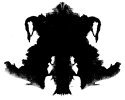posted 05-04-2008 08:59 PM



I've been up and down with excitement and frustration at the TGTBT results of the Mangan et al (2008) survey of Armitage's confession and QC confirmed cases.Dan "100 percent" Mangan has on his website the following information
quote:
Certified in Matte Quadri-Track Polygraph Technique**Shown to be 100% accurate in a study of 122 real-life cases, with no false-positive or false-negative results; recognized by National Academy of Sciences 2003 report on polygraph.
I've read the NRC/NAS (2003) report and I don't recall reading that they had recognized the Matte Quadri-Track Zone.
So, I did what any self-respecting pin-head would do under similar circumstances - I spend the afternoon re-reading the NRC/NAS study, and searching the 400 some-odd page .dpf of the report.
Not only does the report never once refer to the "fear of error" vs "hope of error" hypothesis of Matte, but Matte's name appears only a few times in the report (which is, of cours, more times than my name appears).
- page 137 includes a reference to Matte & Ruess (1992) study, in some discussion about gender-specific findings,
- pages 292 and 295 include refer to Matte's 1996 book, in discussion about polygraph history and Marston,
- there is a footnote on page 320 which refers the reader to Matte's 1996 book for more information on the history of polygraph instrumentation and hardware and for additional historical background on computer algorithm development,
- page 337 (Appendix G) includes a bibliographic entry on Matte & Reuss (1989). A field validation study of the quadri-zone comparison technique. Polygraph 8(4):187-202.
This last entry is the "100 percent" study to which Dan Mangan is referring.
Appendix A does include a list of polygraph techniques that were "recognized" by the NRC/NAS. They list:
- RI test
- Comparison Question tests
- Reid Comparison Question Test (also known as the modified general question test)
- Zone Comparison Test - references the 1963 Backster Zone, which is essentially the Army ZCT, (which does not include the "inside track," the “hokey-pokey,” or $200 for passing "Go.")
- Utah Probable Lie Test
- Utah Directed Lie Test
- Test of Espionage and Sabotage
- Stimulation Test (also called an Acquaintance Test)
- Concealed Information Test
- Peak of Tension Test
So, it does not appear the NAS actually recognized the technique, but included the data in their quantitative analysis.
Moreover, this list is instructive of how the NRC/NAS, and scientists in general, tend to think about testing techniques – in terms of general families of techniques that share basic strategic approaches and basic principles. They do not appear to be impressed with the imprinting/guru approach to techniques regarded as greatly differentiated simply because they are named after their grand-poobahs.
I doubt however the NRC/NAS committee would agree that inclusion in their quantitative analysis would constitute "recognition" of the Matte Quadri-Track Zone technique. To them, it appears to be just another Zone Technique, or just another polygraph technique.
In fact, a thorough reading of Appendix G reveals this from page 334:
quote:
Rather than developing and testing meta-analytic models, we have taken the simpler and less potentially misleading approach of presenting descriptive summaries and graphs. The studies vary greatly in quality and include several with extreme outcomes due to sampling variability,
bias, or non-generalizable features of the study design. Thus, we do not give much weight to the studies with outcomes at the extremes of the group, and summarize the sample of studies with values of the accuracy index (A) that are most representative of the distribution of study outcomes—
the median and the interquartile range.
It sounds like the Matte & Reuss (1989) "100 percent" study is exactly the one to which the NRC/NAS committee is referring when they make this cautionary statement. Clearly, the NRC/NAS does not consider the Matte & Reuss (1989) study to be representative.
This is concerning to me, because one of pointed jabs the more well-educated polygraph detractors and polygraph opponents level at us is the accusation of "quote-mining," wherein we extract the message and meaning we want rather than deal with the message and meaning intended by an author.
The terms "Quadri-Track" or "Quadri Track" do not appear anywhere in the over-400 page text of the NRC/NAS (2003) report.
The term "Quadri" appears once, in the aforementioned bibliography entry on page 337.
Now, I've spoken with Dan Mangan, and I know him to be educated and intelligent. Unfortunately, I believe he's engaging in a bit too much discipleship here, and I'm concerned that this kind of unrealistic and inaccurate hype will do more to hinder our progress at turning the hearts and minds of real scientists.
.02
r

------------------
"Gentlemen, you can't fight in here. This is the war room."
--(Stanley Kubrick/Peter Sellers - Dr. Strangelove, 1964)


 Polygraph Place Bulletin Board
Polygraph Place Bulletin Board

 Professional Issues - Private Forum for Examiners ONLY
Professional Issues - Private Forum for Examiners ONLY

 more dissambiguation on the Matte Python - holy grail technique
more dissambiguation on the Matte Python - holy grail technique






